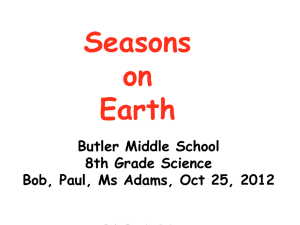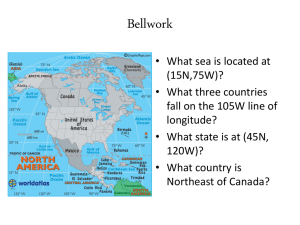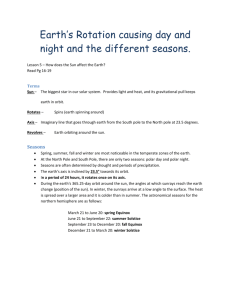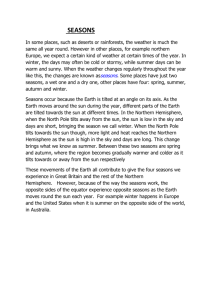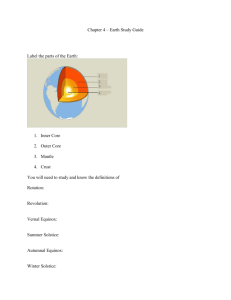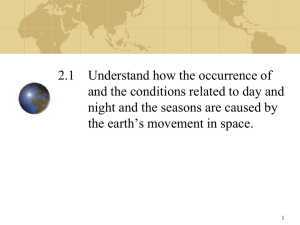Kinesthetic Astronomy-Seasons - Colorado Springs School District 11
advertisement
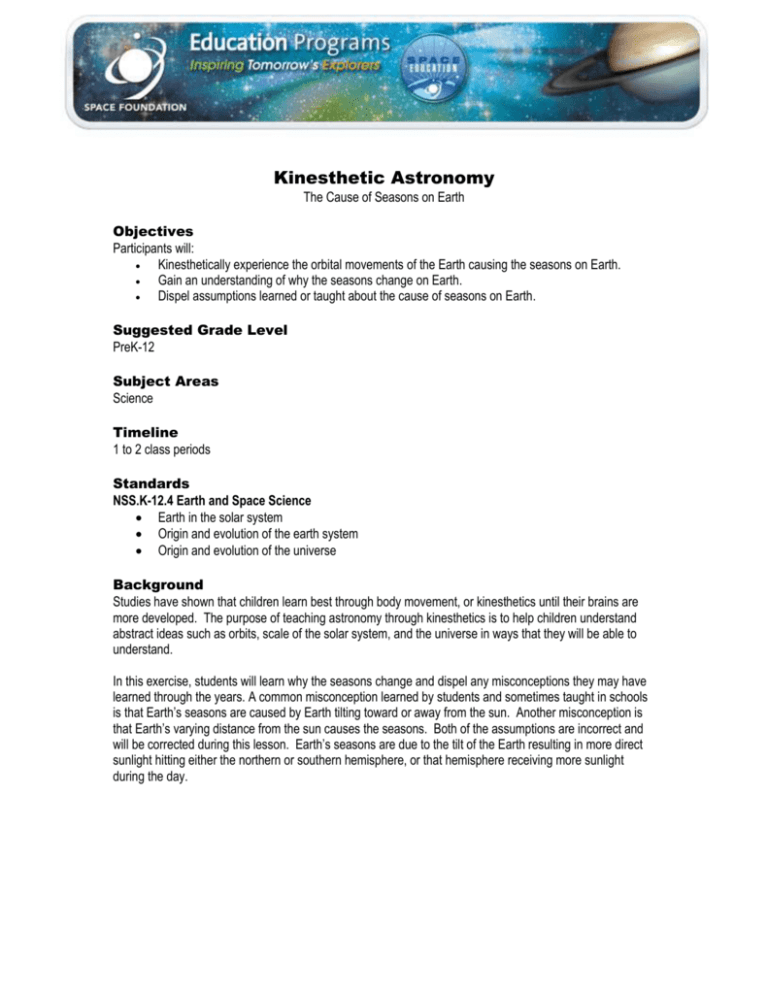
Kinesthetic Astronomy The Cause of Seasons on Earth Objectives Participants will: Kinesthetically experience the orbital movements of the Earth causing the seasons on Earth. Gain an understanding of why the seasons change on Earth. Dispel assumptions learned or taught about the cause of seasons on Earth. Suggested Grade Level PreK-12 Subject Areas Science Timeline 1 to 2 class periods Standards NSS.K-12.4 Earth and Space Science Earth in the solar system Origin and evolution of the earth system Origin and evolution of the universe Background Studies have shown that children learn best through body movement, or kinesthetics until their brains are more developed. The purpose of teaching astronomy through kinesthetics is to help children understand abstract ideas such as orbits, scale of the solar system, and the universe in ways that they will be able to understand. In this exercise, students will learn why the seasons change and dispel any misconceptions they may have learned through the years. A common misconception learned by students and sometimes taught in schools is that Earth’s seasons are caused by Earth tilting toward or away from the sun. Another misconception is that Earth’s varying distance from the sun causes the seasons. Both of the assumptions are incorrect and will be corrected during this lesson. Earth’s seasons are due to the tilt of the Earth resulting in more direct sunlight hitting either the northern or southern hemisphere, or that hemisphere receiving more sunlight during the day. Vocabulary Solar system, rotational period, orbital period, axis, Summer Solstice, Fall Equinox, Winter Solstice, Spring Equinox, northern hemisphere, southern hemisphere Materials “E” and “W” signs An object to represent the sun (a yellow helium balloon on a string works well) Four signs that read “Summer Solstice”, “Fall Equinox”, “Winter Solstice”, and “Spring Equinox” Lesson 1. A common misconception learned by students and sometimes taught in schools is that Earth’s seasons are caused by Earth tilting toward or away from the sun. Another misconception is that Earth’s varying distance from the sun causes the seasons. Both of the assumptions are incorrect and will be corrected during this lesson. Earth’s seasons are due to the tilt of the Earth resulting in more direct sunlight hitting either the northern or southern hemisphere, or that hemisphere receiving more sunlight during the day. 2. Start the lesson by reviewing what was learned during the previous Kinesthetic Astronomy lesson involving the rotation and orbit of the Earth causing day and night. Include in your review the tilt of Earth’s axis at 23.5 degrees. That fact will be the foundation for this lesson. 3. Have students form a large circle around the sun. Make sure there is enough room so they will not run into another student. 4. Remind students that their head is the North Pole, their bottom is the South Pole and their waist is the Equator. 5. Ask the students, “What causes the seasons?” Answers will vary. 6. Explain that today we will find out the cause of the seasons and we will see whose theories were correct. 7. Start by having the students point their North Pole towards the North Star. 8. Explain to the students that each of them represents the Earth orbiting the sun during an orbital period. The Earth always points towards the North Star. 9. Pick the student that is facing the sun directly (northern hemisphere towards the sun). Have the other students stand strait and observe the selected student. Ask the students, “If we were all living at the point where his/her nose is, what season would we be experiencing in the northern hemisphere?” Answer: Summer. Let the students think about that for a minute. 10. Place the sign for Summer Solstice at that location. Explain that the word solstice means a point in which the sun seems to have no northward or southward motion. 11. Ask the students, “Why it would be summer.” Answers may include, because the northern hemisphere is closer. (Note: Technically the northern hemisphere is closer, but when you take into consideration the immense scale of the solar system that minute amount of distance does not make a difference in affecting the weather.) Answer: It is summer in the northern hemisphere due to the area receiving more direct sunlight and longer periods of sun during the day. 12. Have that student do one rotational period so the other students can observe the northern hemisphere receiving more sunlight than the southern hemisphere. 13. Ask the students, “If this Earth’s location during summer, where would Earth’s location be for winter in the northern hemisphere?” Everyone should point to the student directly opposite the summer student. 14. Have that student do one rotational period so the other students can observe the northern hemisphere receiving less sunlight than the southern hemisphere. 15. Place the sign for Winter Solstice at that location. 16. Ask, “If we have summer in this location (pointing to the summer student) and winter in this location (pointing to the winter student) what are the seasons in between winter and summer?” Answer: Fall and Spring. 17. Moving counter-clockwise from summer would be fall, and moving counter-clockwise from winter would be spring. Place the Fall Equinox sign and the Spring Equinox sign in the proper locations. 18. Explain to the students that equinox means equal. These two points are the times of the year when the hours of daylight and darkness are approximately equal. Allow the students time for that observation to make sense to them. 19. Have the students arrange themselves around the circle again with their north poles pointing to the North Star. Have them observe the Earth (students) at different locations around the orbit and help them to understand the different locations mean different amounts of daylight. Thus, resulting in the changing of the seasons. 20. For an added activity, have students align themselves around the sun according to their birthdays using the signs of equinox and solstice as reference marks. Extensions Have students draw the Earth’s orbit around the sun. Have them correctly label: northern hemisphere, southern hemisphere, equator, Summer Solstice, Winter Solstice, Fall Equinox, and Spring Equinox. Evaluation/Assessment Observe student participation and understanding during the lesson. Assess the extension lesson after returning to the classroom. Resources Kinesthetic Astronomy, Morrow, C and Zawaski, M. http://www.spacescience.org/education/extra/kinesthetic_astronomy/index.html National Science Standards: http://www.nap.edu/readingroom/books/nses Summer Solstice June 20/21 Winter Solstice December 21/22 Fall Equinox September 22/23 Spring equinox March 20/21
